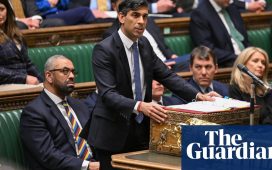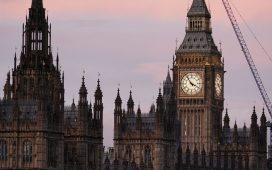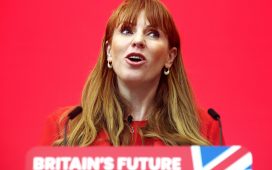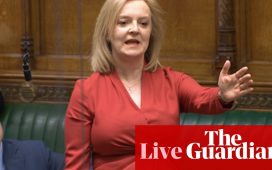The Conservatives say Labour’s £1.2tn spending plans would bankrupt the economy. Labour says all its commitments will be fully costed and that the Tories are running scared. Predictably, it hasn’t taken long for the election to descend into slanging matches, dodgy dossiers and a battle for economic credibility.
In truth, both parties want to have their cake and eat it. John McDonnell, the shadow chancellor, says ordinary voters need not fear his spending proposals because investment in infrastructure will be covered by borrowing, and increases in the day-to-day costs of government – such as pay – will be paid for by higher corporation tax and an increase in income tax for the better off.
Sajid Javid has his own version of cakeism. The chancellor said on the BBC’s Andrew Marr show that his “controlled” borrowing would meet the UK’s public investment needs without the risks that Labour’s more ambitious approach allegedly involve. The Conservative manifesto is likely to serve up another slice of cake with a promise of cuts in national insurance contributions for low-paid workers.
The response of Sir Nick Macpherson, the Treasury’s top mandarin under Gordon Brown, Alistair Darling and George Osborne, suggests that voters might struggle to make much of a distinction between Conservative borrowing and Labour borrowing. “Has there ever been a time when the spending plans of the two main parties have been so incontinent? Borrowing to invest is only sensible if it does not result in ever-increasing debt.”
The Treasury said much the same about John Maynard Keynes’s plans to boost demand when they were first aired in the late 1920s. And the answer from Javid and McDonnell is the same as Keynes’s answer then: if cutting interest rates and printing money is no longer effective, and borrowing is cheap, then it makes sense to borrow money at low cost for projects that will generate an economic return. The higher investment will lead to faster growth, generating enough in higher taxes to pay for the initial capital outlay together with the interest payments on it.
Both chancellor and shadow chancellor have looked back at the events of the past decade and concluded that inflation is the dog that doesn’t bark. When central banks slashed interest rates and turned on the electronic printing presses a decade or so ago, the fear was that money would become worthless and prices would rocket. It simply didn’t happen.
Central banks set interest rates to hit an inflation target – 2% in the case of the UK – and rely on some version of the Phillips curve when making their decisions. Put simply, the Phillips curve says there is a relationship between unemployment and inflation, so that when the jobless total comes down workers are able to secure higher wages, and pressure on the cost of living goes up.
But something has gone seriously awry with the central bank models. For one thing, it took a lot longer than expected for lower unemployment to generate any pick up in wages. And even though there are signs of some pick-up in annual earnings due to a tightening of the labour market, this has not led to higher inflation. When the Office for National Statistics publishes its latest bulletin on the cost of living this week, it will show the annual inflation rate to be below the government’s 2% target.
What seems to be happening is that companies have decided it is impossible to pass on the impact of higher wages to their customers and are accepting lower profit margins as a consequence. Firms respond by cutting back on hiring or by laying off workers, and that leads to a fall in earnings growth. Inflation has remained low and so too have interest rates.
Javid said recently in Washington he thinks low borrowing costs are here to stay and nothing in the past decade would suggest he is wrong. He will take some convincing that there is any real substance to the Treasury’s long-standing fear that extra borrowing for public investment pushes up long-term interest rates, which in turn “crowd out” private investment by making it more expensive to finance. Nor will McDonnell give much truck to Treasury officials giving him the same line if he becomes chancellor. Both men think a more relaxed approach to fiscal policy – tax, spending and borrowing – is a gamble worth taking, and they are right. The evidence is that the multiplier effect of government spending – the amount of extra growth generated for each pound spent – is higher when real (inflation-adjusted) interest rates are low, as they are today.
That said, it might not all be plain sailing. There is a legitimate argument to be had about what constitutes investment, because building a new school or hospital does not in itself increase the productive capacity of the economy. Similarly, the Institute for Fiscal Studies was right to warn that a splurge of unfocused spending might run up against supply constraints, such as a lack of oven-ready projects to invest in.
There is also a danger that the growth-boosting impact of looser fiscal policy might be offset by higher interest rates from the Bank of England. Despite evidence that the Phillips curve relationship has broken down, the Bank still believes it will eventually hold true again. It thinks there is little spare capacity left in the economy and so any increase in the growth rate will lead to higher inflation. It is the Bank’s legally mandated duty to hit the government’s inflation target, so if the chancellor is pumping up demand through fiscal policy the Bank will have to tighten monetary policy to compensate. In those circumstances, Javid or McDonnell would have a choice: suck it up or give the Bank a less demanding inflation target.













